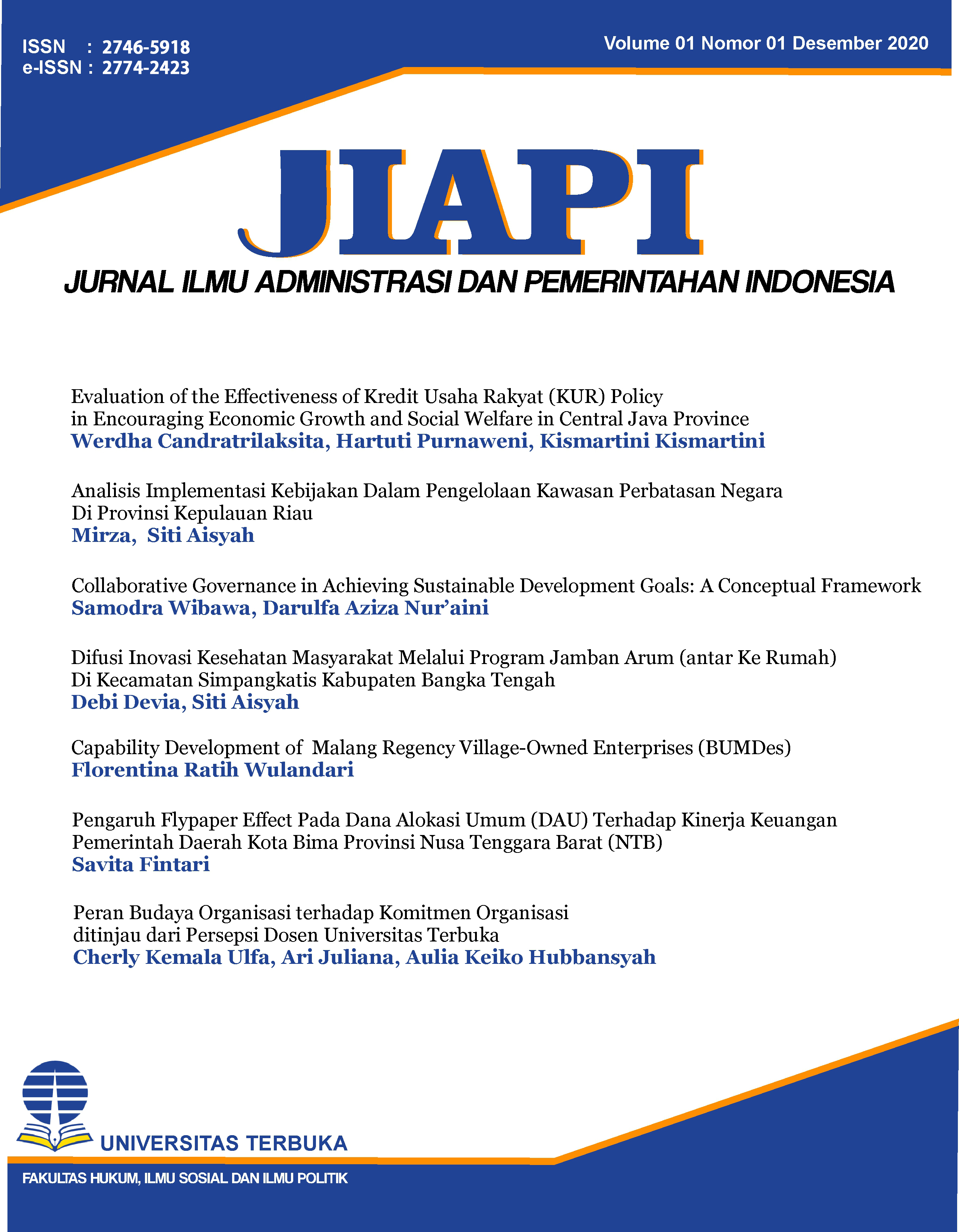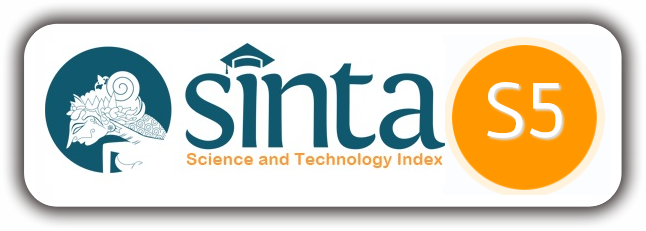Capability Development Of Malang Regency Village-Owned Enterprises (Bumdes)
DOI:
https://doi.org/10.33830/jiapi.v1i1.30Keywords:
capability development, dynamic capability, collaborative governance, village-owned enterprises (BUMDes)Abstract
This paper aimed to describe the capability development of Village-Owned Enterprises (BUMDes) in Malang Regency. The research method used was a qualitative method. Data were collected from key informants from the Malang Regency Office of Community Empowerment and Village, and BUMDes in Malang Regency. The study revealed that there were 203 BUMDes in Malang Regency. They were trained annually for BUMDes by the Ministry of Villages, the Development of Disadvantaged Areas and Transmigration of the Republic of Indonesia as part of capabilities development Malang Regency BUMDes, in collaboration with the Malang Regency Office of Community Empowerment and Villages. The problems often arose in the capabilities development of Malang Regency BUMDes were, (a) socialization and communication program factors had not reached the optimum level yet; (b) lack of human resources who were able to manage the BUMDes (c) they tended to depend on the leadership of the Village Chief; (d) the partnership was too dependent on the sponsor's intention. The limitations of the study were caused by the limited time and location, so it could not cover all regions and other stakeholders. Hence, the study results could not be generalized to other regions. The implications of the studies were to increase the effectiveness of Malang Regency BUMDes capability development and consider providing regular clinics with consultants at the District Office. To improve the efficiency of Malang Regency BUMDes capability development, it was necessary to disseminate a package of practical tools guidance and management training per District, in addition to Malang Regency Training. The originality of these findings was related to the wider picture of beneficial roles of dynamic capabilities and collaborative governance for optimal and sustainable economic empowerment of rural communities.
References
Berdesa.(2016, February 4).Permendesa tentang Jenis Usaha Desa. Berdesa.com. Retrieved from http://www.berdesa. com/permendesa -tentang-jenis-usaha-bumdesa/
Cao, Guangming, Duan, Yanqing, El Banna, Alia.(2019). “A Dynamic Capability View Of Marketing Analytics: Evidence From UK Firms”. Industrial Marketing Management 76 (2019) 72–83 Journal homepage: www.elsevier.com/locate/indmarman
Darawong, Chonlatis.(2018). “Dynamic Capabilities of New Product Development Teams In Performing Radical Innovation Projects”. International Journal of Innovation Science Vol. 10 No. 3, 2018,333-349
Dixon, Sarah, Meyer, Klaus, Day, Marc.(2014). “Building Dynamic Capabilities of Adaptation and Innovation: A Study of Micro-Foundations in a Transition Economy”.(pdf).Long Range Planning Journal 47:186–205 homepage: http://www.elsevier.com/locate/lrp
Fajarwati, Farik.(2018,March 14). 278 Desa ditarget Miliki BUMDEs.radarmalang.com. Retrieved from https://radarmalang.id/278-desa-ditarget-miliki-BUMDes/
Inan, G. Gurkan, Bititci, Umit S.(2015). “Understanding organizational capabilities and dynamic capabilities in the context of micro enterprises: a research agenda”. (pdf). Procedia - Social and Behavioral Sciences 210,310 – 319
Janssen, Matthijs J, Castaldi, Carolina, Alexis, Alexander.(2016). “Dynamic capabilities for service innovation: conceptualization and measurement”. R&D Management. September 2016, Vol. 46 Issue 4, 797-811.
Jatimtimes.(2018, September 28).Perkuat Perekonomian Desa Pemerintah Kabupaten Malang Dorong Pembentukan BUMDES. Jatimtimes.com. Retrieved form http://jatimtimes.com/baca /179828/20180928/161500 /perkuat -perekonomian-desa-pemerintah-kabupaten-malang-dorong-pembentukan-BUMDes/
Kemendesa.(2018,July 24). Jumlah BUMDEs 6 Kali Lipat Melampaui Target RJPMN. Kemendesa.go.id. Retrieved from www.kemendesa.go.id/jumlah-BUMDes-6-kali-lipat–melampaui-target-rjpmn
Kim, Miri, Song, Jaeki, Triche, Jason, 2015. “Toward an integrated framework for innovation in service: A resource-based view and dynamic capabilities approach”. Information Systems Frontiers. June 2015, Vol. 17 Issue 3: 533-546
Lee, Po-Yen.(2018). How To Develop Dynamic Capabilities In Multiunits: The Roles Of International Experience And Career Capital. Management Decision Vol. 56 No. 2, 2018,344-357
Li, Da-yuan, Liu, Juan.(2014). Dynamic Capabilities, Environmental Dynamism, and Competitive Advantage: Evidence From China. Journal of Business Research 67 (2014), 2793–2799
Reza. (2019, March 13). Kemendes PDTT Dampingi Desa yang Alami Proses Perencanaan dan Pelaporan. Liputan6. Retrieved from https://www. liputan6.com/ news/read/3916137/ kemendes-pdtt-dampingi-desa-yang-alami-proses-perencanaan-dan-pelaporan
O`Regan, N., & Ghobadian A.(2004). The Importance of Capabilities for Strategic Direction and Performance.
Piening, Erk P., Salge, Torsten Oliver. 2015. “Understanding the Antecedents, Contingencies, and Performance Implications of Process Innovation: A Dynamic Capabilities Perspective”. (pdf). Journal of Product Innovation Management. Jan 2015, Vol. 32 Issue 1, p80-97
Teece, DJ.(2009). Dynamic Capability and Strategic Management. New York:Oxford University Press Inc.
------------.(2018). “Dynamic Capabilities As (Workable) Management Systems Theory”. Journal of Management & Organization, 24:3 (2018), 359–368. Cambridge: Cambridge University Press and Australian and New Zealand Academy of Management
Ubels, Jan, Fowler, Alan.(2010). The Multi-faceted Nature of Capacity: Two Leading Models. Capacity Development in Practice, Ubels, et al., (Ed.).London: Earthscan
UNDP.(1997). Capacity Development: Management Development And Governance Divisions Technical Advisory Paper 2. New York: UNDP.
Wu, Hang, Chen, Jin, Jiao, Hao.(2016). “Dynamic Capabilities As A Mediator Linking International Diversification and Innovation Performance of Firms in An Emerging Economy”. Journal of Business Research 69,2678–2686
Wanna, John.(2008). Collaborative Government: Meanings, Dimensions, Drivers And Outcomes.Collaborative Governance:A new era of public policy in Australia?.Janine O’Flynn and John Wanna (Ed.).Canberra:ANU E Press
Wulandari, Florentina Ratih, Aisyah, Siti and Samsiyah, Siti.(2019). Model Pengembangan Jejaring Kolaboratif BUMDes di Kabupaten Malang. Jakarta:LPPM UT
Zhao, Shu Liang,et.al., 2013. “Evaluating China’s Regional Collaboration Innovation Capability From The Innovation Actors Perspective: An AHP And Cluster Analytical Approach”. (pdf.) Technology in Society 35,182–190.
Downloads
Published
How to Cite
Issue
Section
License
Copyright (c) 2020 Florentina Ratih Wulandari

This work is licensed under a Creative Commons Attribution-ShareAlike 4.0 International License.
An author who publishes in JIAPI: Jurnal Ilmu Administrasi dan Pemerintahan Indonesia agrees to the following terms:
- The author retains the copyright and grants the journal the right of first publication of the work simultaneously licensed under the Creative Commons Attribution-ShareAlike 4.0 License that allows others to share the work with an acknowledgment of the work's authorship and initial publication in this journal
- The author is able to enter into separate, additional contractual arrangements for the non-exclusive distribution of the journal's published version of the work (e.g., post it to an institutional repository or publish it in a book) with the acknowledgment of its initial publication in this journal.
- The author is permitted and encouraged to post his/her work online (e.g., in institutional repositories or on their website) prior to and during the submission process, as it can lead to productive exchanges, as well as earlier and greater citation of the published work (See The Effect of Open Access).
Read more about the Creative Commons Attribution-ShareAlike 4.0 Licence here: https://creativecommons.org/licenses/by-sa/4.0/.













